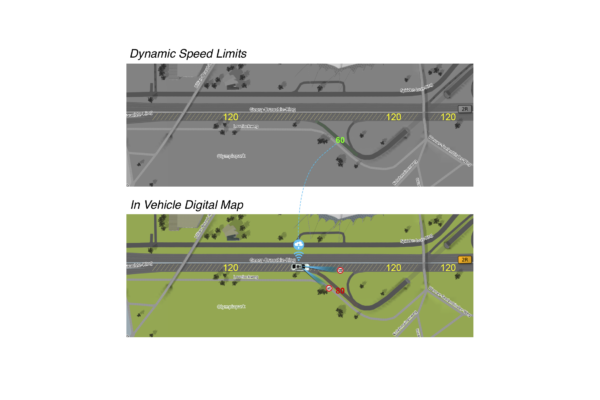
Harman’s Dynamic Map Layers Solution, running on the company’s in-vehicle Compute Platform, dynamically identifies differences between the map data stored in the navigation system and the real-world information gathered by driver assistance systems and other vehicle-based sensors. In particular, the system identifies road signs and compares them with the ones provided by the navigation map vendor and stored in the navigation system. Once a difference has been identified, these data are transmitted to Harman’s cloud platform after they are anonymized for data privacy reasons. There, they are synchronized with the data of other similarly equipped vehicles. Spatial deep learning algorithms then identify on the fly the correct road situation and feed the adjusted map data back to the vehicles. Thus, drivers always can use a constantly updated data base and are always informed on the real road conditions and traffic routing.
This includes, for example, newly defined speed limits, construction sites and other changes to the signposting along the route. Harman has also developed state-of-the-art hybrid learning algorithms that ensure highly accurate updates, with little storage requirements on the in-car systems and highly efficient wireless data transmission.
The solution is based on the open Navigation Data Standard (NDS). Thus, dynamic map layer data can be exchanged freely between vehicles and navigation systems of different brands. It also enables competing OEMs to collaborate in providing comprehensive real-time presentation of the road network.
With increasing number of sensors in cars, this standard-based solution can be used to update existing road maps. It also supports HD card content, which is required for various security and autonomous applications in the networked vehicle, Harman says.
The system is already in use in a series vehicle of a large German carmaker. As usual, Harman did not elaborate as to the name of this customer.
Related articles:
Data standard for autonomous navigation wanted
Here launches sensor-based real-time traffic data service
 If you enjoyed this article, you will like the following ones: don't miss them by subscribing to :
eeNews on Google News
If you enjoyed this article, you will like the following ones: don't miss them by subscribing to :
eeNews on Google News



